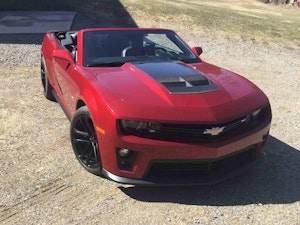Media | Articles
How to Rodent-Proof Your Car
“I hates those mieces to pieces” is how one cartoon cat used to put it, and most old-car hobbyists will agree. Mice – and other varmints – don’t just stink up Stanleys and Studebakers. They can ruin carpets, chew through electrical wires (sometimes causing a fire), nest in heaters and create a downright unhealthy environment inside your vintage vehicle.
Keeping furry little creatures out of cars is high on the priority list of collectors. Solutions to the problem have ranged from Rube Goldberg-like contraptions to sonic waves to zipper bags that you drive your car into.
The Funniest Mouse Trap Award goes to the man who took a metal pail, removed the handle and stuck a long “axle” through the holes. Then he rigged a spoon to act like a pendulum that rotated on the axle. A gob of peanut butter balanced the spoon, and a piece of wood made a gangplank the mouse could walk on to almost reach the peanut butter. The pail was filled with antifreeze. When the mouse jumped on the spoon to eat the Skippy Smooth, he made the pendulum swing and it tossed the rodent into the liquid. The inventor swore this setup worked.
The best way to keep a mouse out of a car is to keep him out of the building in which the car is housed. Make sure the building has a “rat guard” barrier that goes around the bottom of the structure and into the ground, preventing pests from burrowing in. If there are gaps on the bottom of the walls, fill them with steel wool. Keep doors and windows sealed as tightly as possible. Use metal collars or rubber gaskets to seal openings for electrical wires, fuel lines and pipes.
Keep food out of your building and cars. If there’s nothing for mice to eat, they won’t stick around. Don’t leave scraps or crumbs inside the vehicle. Vacuum the carpets, seats, under-seat area, console and glove box. Use probe tools to get at the petrified French fries on the side of the seat. Shampoo the carpets so they are squeaky clean and smell fresh.
Marketplace
Buy and sell classics with confidence
Traps and poisons are a line of defense against unwanted furry visitors. They come in a variety of models and prices. They work, but remember that traps are designed to attract mice and then kill them. Keeping the mice away in the first place works best.
Cats kill mice, but cats also like to roost on cars and may leave claw marks in the paint. Heavier cats can ruin convertible tops. Cats also require food that can actually attract mice, so keep them out of your garage/storage building.
In most cases, mice and vermin enter a car by scampering up the tires. If the vehicle is stored without tires, it is a bit harder for them to get inside. Tireless storage will also keep your tires from “flat spotting.”
Rodents can nest several places in a vehicle: the engine compartment, the interior and the trunk. They’re drawn to the warmth of an engine or heater motor. They will eat electrical wires and even spark plug wires. Recently a collector stumbled upon a simple way to keep an engine bay mouse-free – leave the hood up. After he inadvertently left his hood up, his mouse problem was solved.
Vermin can also get into cars through holes around cables, pedal shafts, steering columns and so on. If you can seal all these openings, mice can’t enter. Leave the sun visors in the down position. If you want to keep the windows slightly open for better airflow, cover the opening with screening.
Usually, these creatures can’t get into a trunk if you seal interior openings; they usually enter the trunk from the rear seat. Some cars have drain holes in the spare tire well. These holes should be taped.
Some people put mothballs on the floor around the car. The line of mothballs should have no gaps at any point. Other collectors place mothballs or scented soap in a cake pan inside the car to keep mice away. Mice don’t like the mothball smell, but neither will your friends. If you go the mothball route, eliminate the smell by putting a Yankee Candle under the seat on a hot day.
Zipper bags seal the whole car. There are two types. The first is a big plastic sack with a zipper. A second type is a plastic bubble supported by a curtain of air. The air pump draws little current and promotes better airflow. Both bags work well if you use them properly. The trouble is the hassle. You must be very careful not to trap moisture in the bag. While the air-curtain type won’t trap moisture, it does require electricity.
One final step in fighting rodent infestation is to make spot checks every couple of weeks. If you see droppings or notice that unpleasant mouse smell, the steps you have taken so far aren’t working. In this case, the first thing to do is to get rid of the mice. Then you’ll need to protect the vehicle from being re-infested. If you inspect the car on a regular basis, you should be able to remedy the problem before damage is done.
John “Gunner” Gunnell is the automotive books editor at Krause Publications in Iola, Wis., and former editor of Old Cars Weekly and Old Cars Price Guide.











“The best way to keep a mouse out of a car is to keep him out of the building in which the car is housed.”
hah, some folks don’t have the luxury of keeping vehicles inside a building.
There’s never been food in my car and I still get rodents inside. we live in a rural environment, some actual helpful info would be nice.